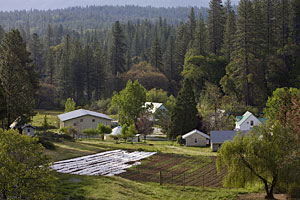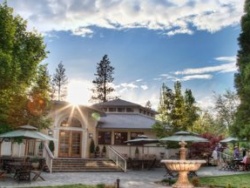View overlooking Ananda Farm
While sustainability is not the defining tenet of life at Ananda Village, we have always strived to live in healthy harmony with our natural environment. We live simply, balancing what we need to do in order to play a dynamic and positive role in life, with the impact our use of energy and resources has on the world. We also recognize that the human race must evolve new ways of using energy and natural resources that are in harmony with the natural world, and we apply ourselves creatively to innovating new ways to live sustainably. Since the 90s, individuals have increasingly moved to the use of small electric vehicles, bicycles and walking as a means of transportation around the Village.
Humanity forms a part of the web of life, and we have a particular responsibility to nurture and protect the relationships that we have around us. The central function of Ananda Village is to nurture the search for God. Care of God’s creation is a responsibility.
Growing Food
Ananda currently has 6 acres of CCOF (California Certified Organic Farmers) farmland fenced and irrigated in the Village center, as well as another 10 acres in gardens and orchards near individuals’ homes. Members run CSAs (community supported, or subscription agriculture) providing eggs, goat and cow milk, honey, vegetables and fruit. We have converted one of our oldest orchards into a multilevel, self-sustaining food forest designed with the principles of permaculture.
Housing and Buildings
Our homes tend to be much smaller than the societal norm. Homes are sited to maximize solar exposure, and built in clusters to work efficiently with infrastructure and to conserve resources. In 2011, the Village installed photovoltaic solar arrays in conjunction with programs and incentives offered by the utility companies and state and federal governments. The solar arrays have been installed at 13 sites to service the community’s largest users of electricity.
The new Living Wisdom Center on the Ananda school campus was constructed of blocks formed from recycled wood chips. The building was designed to combine sustainable design elements with a beautiful and uplifting form. At least a third of our houses are heated with wood, much of it cut from Ananda’s woodlands. Energy efficiency is a priority when remodeling existing homes, and especially in the construction of new homes.
Water Use
The Ananda Village water supply comes from wells on the land. Sewage is likewise disposed of in onsite septic systems that ultimately return most of the water used to groundwater aquifers. We are currently experimenting with the most efficient way to use gray water for food production and landscape maintenance. During the current period of drought, we have initiated a cooperative effort to reduce water consumption by 20% per household.
Land Use
Ananda has the great advantage that it is owned, developed, and managed cooperatively by the people who live in the community. The profit motive (housing as an investment and speculation) have been absent from Ananda Village from the beginning. The land is held and managed for the present and future, to welcome residents and visitors to inspire and aid in their spiritual search.
In over thirty years of land use planning, a number of key principles have guided our development of the land:
- Cluster development in regions of denser development, leaving the majority of Ananda Village as open space
- Leave open scenic views, and provide view corridors where people walk or drive
- Create and nurture places of beauty and awe
- Create a quiet and uplifting environment conducive to meditation and inner life
- Develop the land to serve a variety of uses and a diverse population of all ages, from young children to elders
- Foster the development of trails for walking and bicycling
- Maintain a variety of wildlife habitats
- Promote the production of food through dedicating land and water resources to agriculture and animal husbandry
Woodlands and Fire Prevention
The majority of the land at Ananda Village is mixed oak and conifer woodlands. In 1976 a wildfire burned through hundreds of acres of Ananda’s land. After more than three decades, the forest is maturing once again. The heavy undergrowth of manzanita and ceanothus, which grew rapidly after the fire, is now beginning to be shaded out by pine, fir, oak and madrone trees that returned after the fire. Also, in conjunction with the California Dept. of Forestry and the Natural Resource Conservation Service, an 11 acre area was mechanically cleared and replanted with conifer seedlings.
Wild fire is a natural part of the Sierra Nevada ecosystem. Since the mid 19th century, fire has been suppressed. The resulting forests have much more vegetation, particularly young trees and brush close to the ground, and are susceptible to catastrophic wildfire. As a result, rather than helping to clear the forest and restore health to a forest ecosystem, today’s fires tend to burn so hot that they are capable of completely destroying the entire forest. The clearing of the understory of grasses and brush, which is the natural effect of a normal forest fire, now has to be achieved in other ways.
Ananda uses mechanical means to reduce understory vegetation, especially near buildings. Fuel reduction zones of 100-300 feet are maintained and constructed around the houses. Trees are limbed up and all ground fuels are eliminated and maintained by periodic mowing. The long term goal is a shaded fuel break, with well spaced large trees providing a shade canopy that represses most undergrowth.













